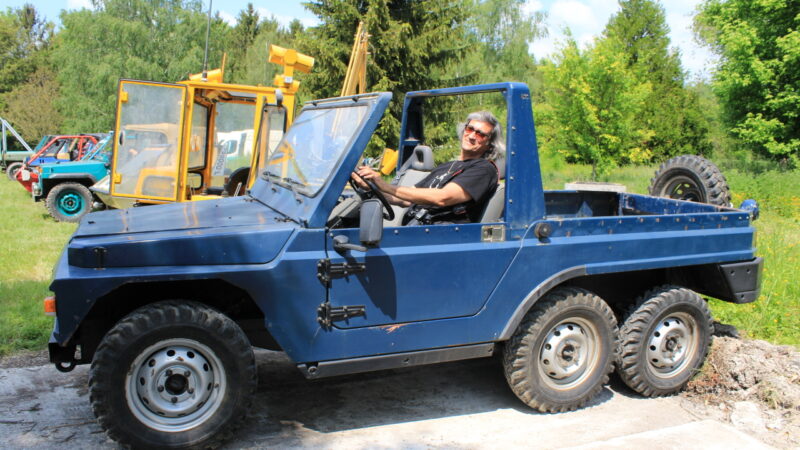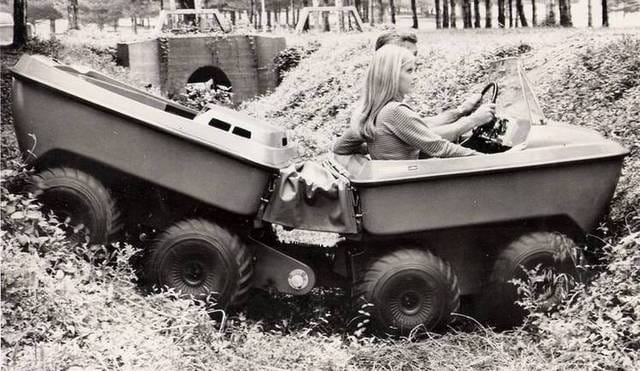Makar 6×6 Ural 2011
What Lies Beyond
By Robb Pritchard
A British 4×4 tour company takes intrepid off-roaders to the wilds of Arctic Russia on what they bill as the ‘Ends of the Earth’ Expedition. When the tide of the White sea is out you drive 30km down the beach to a forlorn, bleached-wood settlement where a few 4x4s are parked. Across the choppy deep-blue estuary are some more houses but I hesitate to call it a village. There are no cars on the other side because you are standing at the furthest place it’s possible to drive to on the north east of the European continent. I know this well because I run World 4×4 Adventures and know just how wild and remote the stunning Kola peninsula is… but then at one of the extreme off-roading competitions Russia is famous for I met Alexey Makarov and he began telling me about his trip about 1000km east of what I thought was the ‘last drivable point in Europe’.
“But how?” I asked little incredulously. “There are no roads!”
Unknowingly emulating the immortal words of Dr Emmet Brown at the end of Back to the Future he replied, “Roads? We don’t need roads!” A DeLorean with Flux-capacitor (I’ve always wanted to write that in one of my articles!) he didn’t have, but two huge 6x6s with tyres so huge that the vehicles actually float, he did! They are called Makars and when you stand next to them they are stunning vehicles. They look like they are ready to be sent to survey the surface of distant worlds and as Alexey clicked through his photos on his well-travelled laptop it looked like that’s exactly what he’d just done. The shots he was casually clicking through were from a recent 26 day, 3200km off-road expedition that stretched the length of the Ural mountains, the curving back bone that separates Europe and Asia. We from the west would spend much more time on the PR than on the journey itself… but not the Russians. They’ll tell you the story if you’re interested but instead of boasting about what they did, they are masters of understatement. But everything about this trip seems incredible… the sheer distance, the places they went to, the amazing vehicles… as well as Alexey’s humility. Pretty much anyone else I know would be celebrating this as a lifetime achievement.
“It was very interesting,” he said. “We started in Ivdel, a town if you look at it on the map pretty much half way from the border of Kazakhstan and the Arctic coast and our final destination was the last piece of land, a thin sandbar that points roughly in the direction of the North Pole, which is all that is left of the mountains as they sink into the sea.”









First of all the vehicles. Although they look like absolutely bespoke machines they’re actually based on the chassis and running gear of a Toyota Land Cruiser 78 (with 80 Series axles). Because they are designed to withstand the insanely cold Siberian winters the body is fully insulated and they can carry a two week supply of fuel and food for the 4 passengers… that’s a 400 litre tank of fuel! It’s nearly 6 metres long, weighs 2500kg unladen and the six 1.3 meter tall tyres contain so much air that, as incredulous as it sounds, the Makar floats quite easily.
“But the journey didn’t start all that well,” he smiled. “On the very first day we learned the lesson that little issues can cause big problems and looking back maybe it was important that we learned it at the start… Because the Makar is based on an imported Japanese Land Cruiser it is right hand drive and with the balloon tyres the width is 2.4 metres… so it’s quite an unusual vehicle for someone more used to driving a Lada Niva and just after we set of we found that it didn’t quite fit between two trees. The tyres didn’t do any more than strip off a bit of bark but between them the axle was bent. So, what to do? Well, we’d all taken a month off work, out of our lives, so should we just go back home? Hell no! It would have been possible to take the shafts out of the front axles and carry on with just drive to the rear four wheels but we knew that the coming route would be too hard not to have an axle driving and so we needed to fix it. After half a day rigging up two winches, using chain saws, ropes, hammers and mentioning someone’s mother in less than positive tones it was clear that we would be going further… even if we needed to wait two days for someone to come and find us with the new parts.
But we soon saw that the wait was worth it. The day we started going again we came to the Dyatlova pass, a really remote place that only extreme hikers ever see and we found a raft of fishermen beached in the river, the sad look of doom in their eyes. What do you think we did? Yes, we floated the Makar into the river, secured their raft to the back of it and pulled them down stream to deeper water. More than the driving, for me it’s the moments like that which stay stronger in the memory.
The plan was not to find the hardest route possible away from any roads or civilization but to use tracks and ‘winter’ roads that went in our general direction. A winter road is frozen for a few months, and up where we were maybe half a year or more, so it’s passable for 4x4s but in autumn they are rivers of mud and all you can do is ease ahead at 10km/h. Many times the tyres loose grip and you have to winch. It’s slow and hard work but you just have to keep the positive mind that you are still going ahead, that you are still making progress. Sometimes it’s easier just to find a route through the trees to the side, but then on the broken branches you have problems with punctures in the tyres and this was the biggest and most constant problem for us. A hole would easily take three hours to fix and this added to the sense of needing to hurry up as we’d lost those three days at the start. So those who wanted to just get out and enjoy looking for mushrooms or berries, or to hunt as we had one guy with us who wanted to shoot absolutely anything that moved, were always told to hurry up.
And the best memory? The others agree that they see the whole expedition a a wonderful experience as a whole, but for me there is one. We’d been driving north for something more than three weeks when we came across a small camp of reindeer herders. These people are kind of mythical to Russians, no normal person from a city would ever see them in their lifetime, but we had somehow managed to cross some imaginary boundary and entered their world. They have lived the same way for hundreds of years, taking only a few things from our modern society and living in balance with nature and the ways of their ancestors… and I think that it’s a beautiful life because they have to live in such harmony with the land. It’s a lesson that perhaps the rest of us need to learn. It looked like there was no one around, they were all away with the herds we guessed ,but then there was one young woman waving at us. It was as though she was from another world, one so far from our own, and it was like being in a spell as she started speaking our language and invited us into her tent. Inside it was warm, cosy and clean and you know, I wanted to stay in this tent, in this world, to leave everything and to trust the fate of the ancient ways of following the reindeer… But this is not out world…
And at the end at the very north of Russia you would perhaps think that our way would get harder and harder, but actually no, it wasn’t like that. The final 200km is a road built next to the new Gazprom oil pipe. It’s closed to normal traffic of course, but for us it was easy to find a way up the bank and then there was a very new sensation for us, speeds of 75km! After so long in the pristine and untouched wilderness we were worried that the company would have made a terrible mess as they lay the pipe, but thankfully no. Happily it seems that Russian companies are much more sympathetic to the environment than they used to be.
And suddenly we were approaching the last waypoint on the GPS and with the wind in our faces it seemed as though it was all ending too quickly… but then with perfectly still water all around us we were almost there. When finally the sand is gone and we are parked in the water, we are at the end of the earth. It doesn’t end in dramatic cliffs with the ocean crashing below but rather like the tips of a dead man’s fingers… pointing at something but it doesn’t matter what because it’s not part of our world…”
A lyrical introduction, perhaps, miss.
The main parameters:
Dimensions long. 5800mm.
wide. 2400mm.
height. 2450mm.
Weight (dry) 2540kg.
Toyota Motor 1KZ-TE turbo diesel 130 l / s. Automatic transmission.
Bridges TLC-80 c locks.
Wheels TREKOL 1300H600H533.
Razdatka from Surf modified.
TLC-78 frame aspect ratio.
The body of the titanium tube 38/2. Lined with 1.2 mm duralumin. Izolonom insulated 20 mm, sheathed Carpet inside.
The total capacity of 400 liters tanks.
Capacity 4 people. (Sleeps 4)
Carrying capacity of 1 ton. (400 liters of diesel, 4 people with the things necessary accessories for the road)
Consumption 15.5 l/100km on the pavement at a speed of 70 km / h (actual), 4 l / h on the road (estimated).
Comfortable on asphalt speed of 70 km.
The maximum speed reached 107.5 on GPS. (Chance on overtaking)
Donor for the construction of TLC-78 Makarov, cars bought at auction in Japan, with a range up to 100,000 miles.































































